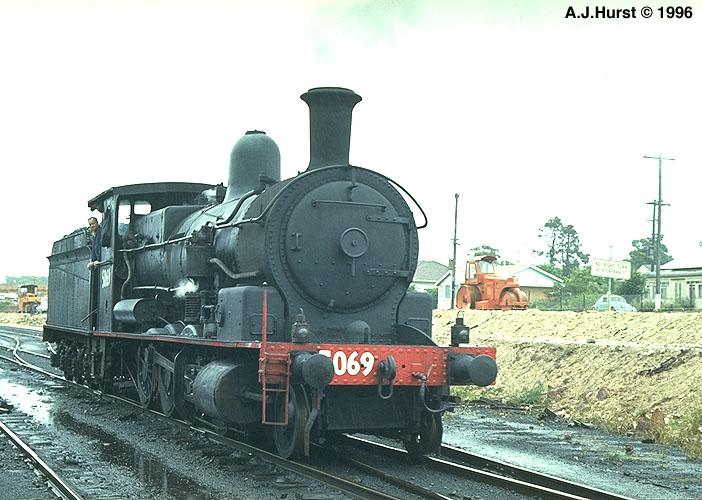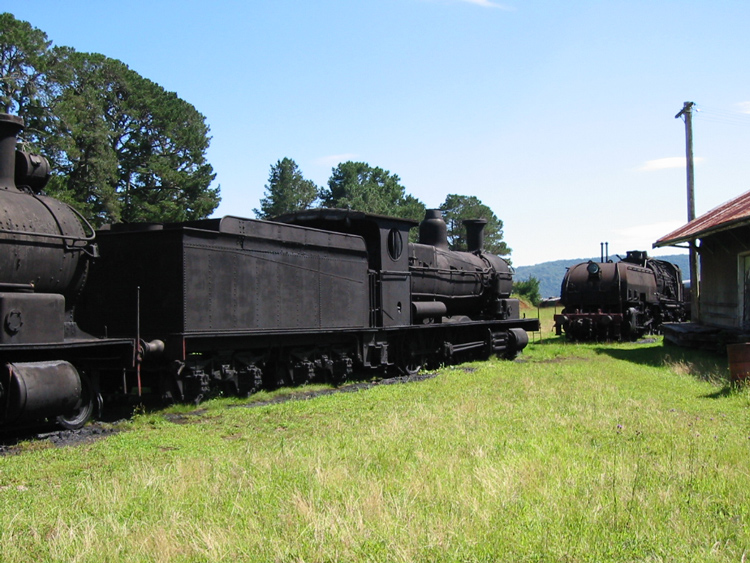|
|
5069 Stored for the Dorrigo Steam Railway & Museum |
|

This photo is courtesy of John
Hurst, showing 5069 shunting in the rain at Waterfall in 1973.
|
Builder |
Beyer
Peacock & Co, Manchester |
|
Builder’s Number & Year |
4374 of 1902 |
|
Wheel Arrangement |
2-8-0 |
|
No. in class |
280 |
|
The
T(524) class 2-8-0 freight engines were the most
numerous class of locomotive in Australia with 280 examples delivered to the
New South Wales Government Railways.
This very successful type was one of the three standard classes
designed by NSWGR Chief Mechanical Engineer William
Thow in conjunction with Beyer Peacock &
Co. The choice of wheel configuration
followed earlier NSWGR experience with Baldwin-built 2-8-0 locomotives in
heavy freight duties, notably the J(131) class
dating from 1879 and the J(483) class of 1891 which excelled over the
difficult Blue Mountains line. The
2-8-0 wheel arrangement had been developed by Baldwin for heavily-graded
mountain railways in Colorado, with the J(131) class
effectively being copies of these pioneering US machines. It is interesting to consider the influence
of this American experience on Thow’s design for
the T(524) class, given the earlier dominance in NSW
of English railway designs and practice. The
T(524) class was further developed by the addition
of superheating, with the final 75 engines delivered with this
enhancement. Many of the earlier
saturated engine were progressively converted to superheating and these could
be easily identified by their extended smokeboxes. The T(524) locomotives
were reclassified to (D)50 in the NSWGR renumbering scheme of 1924. The
successful T(524) design also formed the basis of the
later TF(939) class (190 examples) and K(1353) class (120 examples) to
provide a grand total of 590 “Standard Goods Locomotives”. These engines became the backbone of the
NSWGR freight fleet, with Standard Goods Locomotive allocated to most engine depots
around the state. An interesting chapter in the (D)50 story concerns 10 superheated engines which never made it to Australia; these North British-built examples were requisitioned by the British Army's Royal Engineers Railway Operating Division (ROD) for service in Europe during World War 1. Most came into Belgian State Railways ownership after the war but were not fated with long lives. Including these 10, the total number of Standard Goods Locomotives constructed was 600, although only 590 were delivered to the NSWGR. 5069
was first issued to traffic as T 619 on 4 March 1903, being renumbered to
5069 in 1924. It was one of 88 steam
locomotives used to provide dead weight during load testing of the Sydney
Harbour Bridge prior to its opening in 1932, with a photograph in the Sydney
Harbour Bridge museum (located in one of the bridge pylons) clearly showing
5069 at the head of a string of locomotives on the former tram lines. 5069 had a long service life with the
NSWGR, being officially withdrawn as late as April 1973 at the age of 70
years and with a total distance travelled of 2,313,746km. 5069 remained a saturated-steam locomotive
during its working life and thus represents the T(524)
/ (D)50 class as first designed and built.
It is paired with a 3650-gallon tender of the type originally supplied
with the class. 5069
was stored with the last remaining NSWGR steam locomotives at Enfield
Roundhouse during the final clean-out in late 1974 which saw sisters 5133,
5375, 5407, 5456 and 5483 among the last NSWGR steam locomotives sold for
scrap. Fortunately 5069 avoided this
fate when purchased for the collection of the proposed Hunter Valley Steam
Railway & Museum (HVSR&M) and transferred to their Rhondda Colliery
base near Newcastle. Here 5069 was
occasionally steamed for shunting duties, earning the nickname “The Duchess”
among HVSR&M members. This
organisation later changed its focus to reopening the Dorrigo branch line on
the NSW north coast, so 5069 and other exhibits were rail hauled to Glenreagh
in late 1983, with 5069 and 3028T working the official re-opening train to
Dorrigo in 1986. 5069 and other
Dorrigo Steam Railway & Museum locomotive exhibits have since been stored
on the former potato siding in Dorrigo station yard. (A contemporary account of the DSR&M is
documentary “The Rag Tag Railway” which includes good action sequences
of 5069 in steam.) Unfortunately the Dorrigo Steam Railway &
Museum is not open to the general public and hence access to the
collection is restricted. An excellent resource for further reading on the T(524) / (D)50 class is “ Standards in Steam – the 50 Class” by Ron Preston, while a companion title “Standards In Steam – The 53 & 55 Class” completes the Standard Goods Engine story. Technical details for the T(524) / (D)50 class locomotives can also be found on Wikipedia. |

5069 keeps company with 5132 and 6039 on the former potato
siding, Dorrigo station on 24 January 2004.
References
|
a |
“Standards
in Steam – the 50 Class” by R. G. Preston, Published
by Eveleigh Press, 1992. |
|
b |
"A
Compendium of New South Wales Steam Locomotives" compiled by Alex Grunbach, published by the Australian
Railway Historical Society, New South Wales Division, 1989. |
|
b |
Kramer, J. 'The Dorrigo Steam
Railway & Museum - an Illustrated Guide', published by the Dorrigo Steam Railway & Museum, 1987. |
|
d |
‘Steam
Locomotive Data’ July 1974 edition, compiled by J. H. Forsyth for the Public
Transport Commission of NSW. |
|
e |
Wikipedia
entry for the NSWGR D50 class, retrieved 29 July 2015 |
|
f |
Webmaster's
observation or comment |
Page updated:
10 August 2015
|
Government Railways: |
|
|||||||||
|
Private & Industrial Railways: |
|